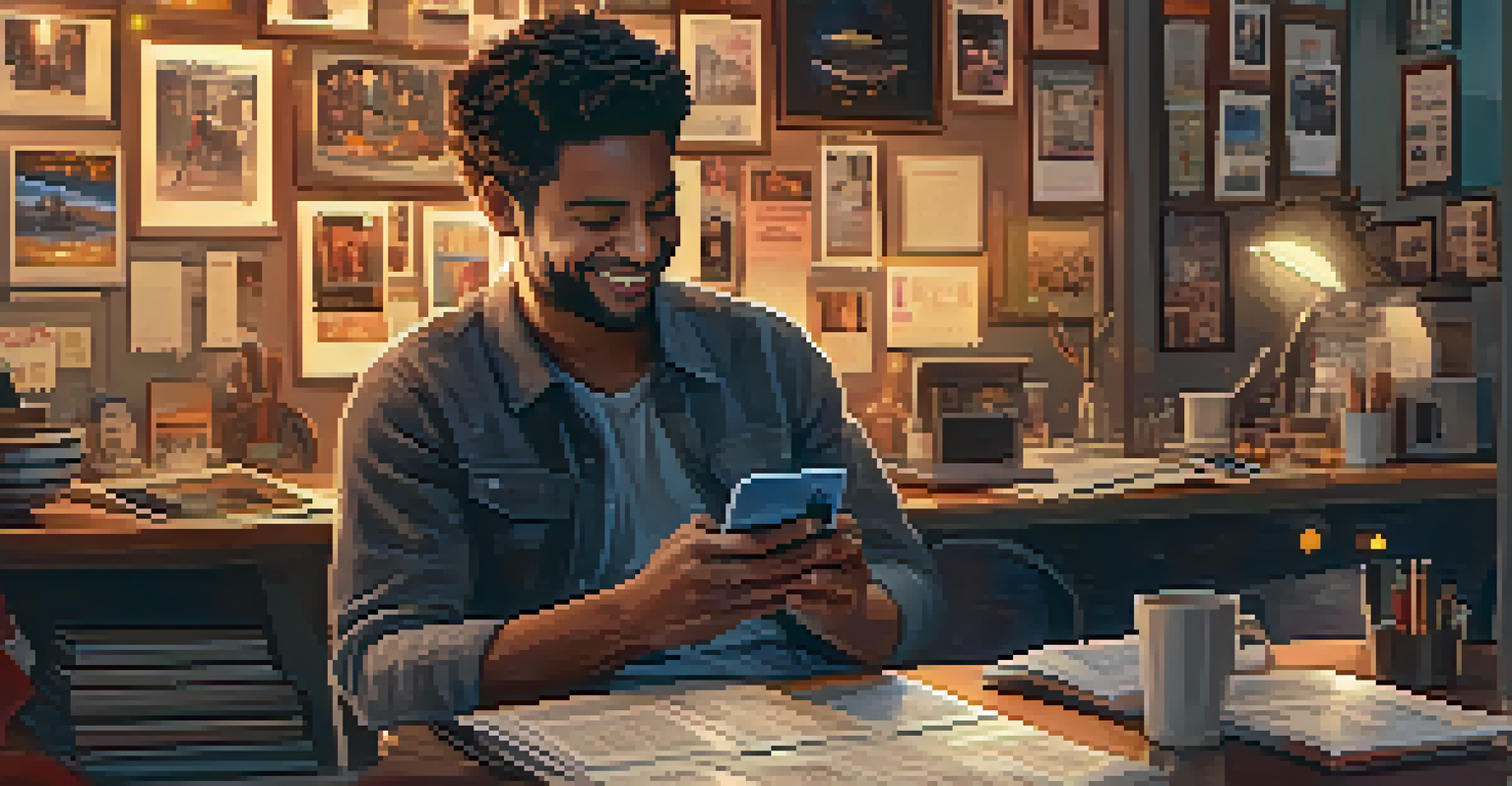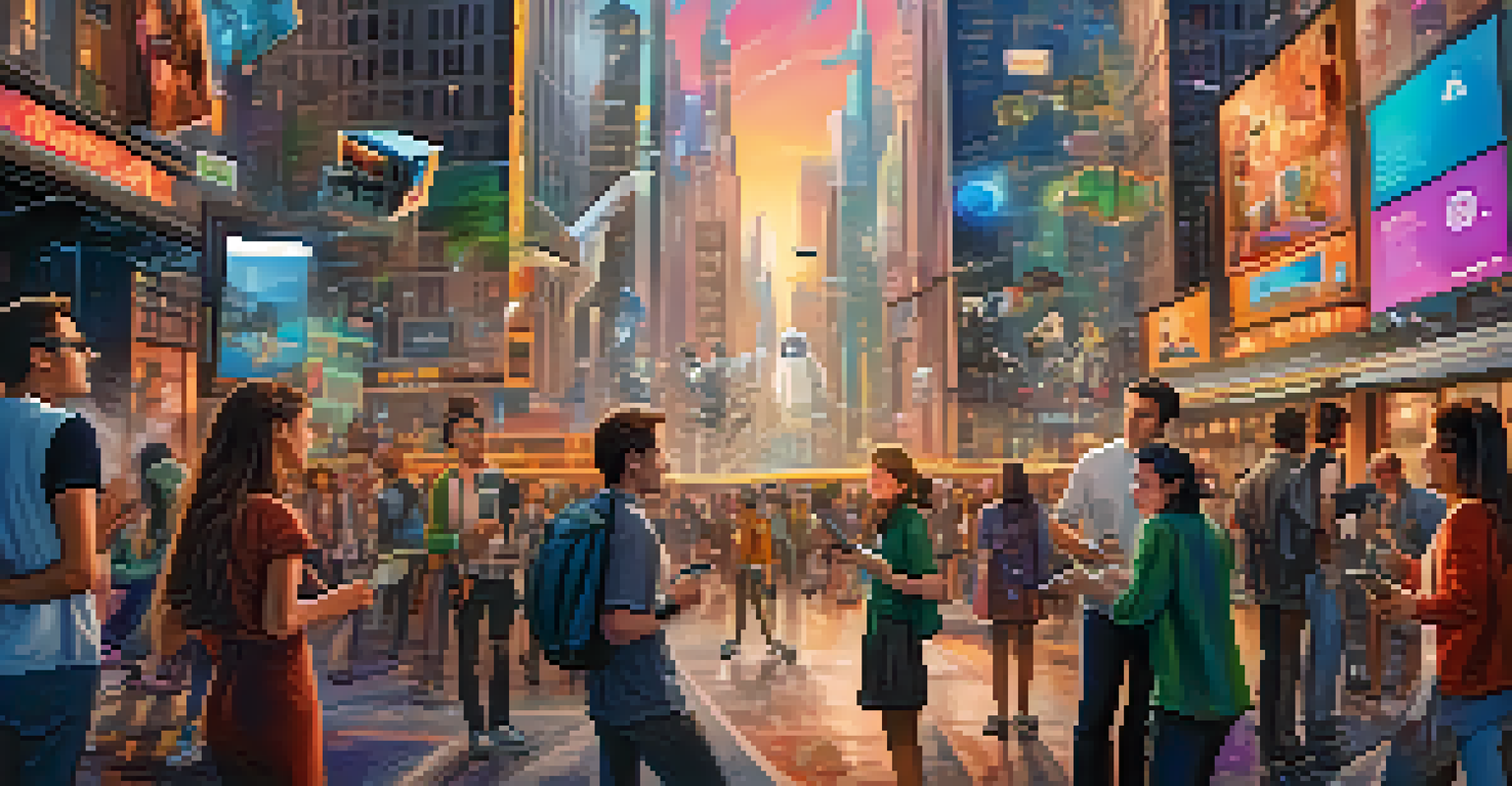The Influence of Social Media on Modern Film Styles and Trends

Social Media: A Game Changer for Film Promotion
In today's digital age, social media has transformed how films are marketed. Gone are the days when traditional advertising ruled the roost; platforms like Instagram and Twitter now play pivotal roles in reaching audiences. For instance, teaser trailers and behind-the-scenes content shared on these platforms create buzz long before a film's release.
Social media is not just a tool for communication; it is a new way of storytelling that connects us all.
This shift not only allows filmmakers to connect directly with their fans but also enables them to gauge audience reactions in real-time. By leveraging social media, studios can adjust marketing strategies based on viewer feedback, ensuring a more targeted approach. It’s like having a focus group at your fingertips, ready to provide insights at any moment.
Moreover, viral moments can propel a film to success, demonstrating the power of social media influence. A single trending hashtag or meme can lead to increased ticket sales, proving that the digital landscape is now a crucial player in the film industry.
Changing Aesthetics: Visual Styles Influenced by Social Media
Social media platforms are not just about promotion; they also influence the aesthetic of modern films. Filmmakers are increasingly adopting visual styles that resonate with the quick, eye-catching content typical of social media. Think of the vibrant colors and dynamic editing seen in films that mimic the fast-paced nature of TikTok videos.

These visual choices not only attract younger audiences but also create a sense of familiarity. When viewers see cinematic techniques that mirror their favorite social media content, they feel more engaged and connected. This melding of styles results in a fresh and dynamic viewing experience.
Social Media Transforms Film Marketing
Platforms like Instagram and Twitter enable filmmakers to connect with audiences directly and shape marketing strategies based on real-time feedback.
Additionally, the rise of influencers has led to a new form of storytelling. Films now often incorporate social media themes, showcasing characters who are content creators themselves, reflecting the realities of today’s digital culture. This evolution of storytelling makes films more relatable to audiences who live their lives online.
Narrative Structures: Shorter, Snappier Stories
With the attention span of audiences dwindling, filmmakers are adapting their narrative structures to fit a more concise format. Social media encourages quick consumption, and this has spilled over into filmmaking, leading to shorter scenes and tighter plots. Films are now crafted to deliver impactful moments swiftly, much like scrolling through a feed.
The future of cinema is the future of its audience and their engagement with the story.
This trend is exemplified by the rise of anthology films and series, where multiple short stories are woven together. By doing so, filmmakers can cater to diverse tastes while keeping the audience engaged. It’s a bit like a playlist of your favorite songs—short, sweet, and packed with variety.
Moreover, the popularity of platforms like YouTube has also influenced how stories are told. Filmmakers are increasingly experimenting with episodic formats and cliffhangers, creating a binge-worthy experience that keeps viewers coming back for more. This evolution reflects a growing desire for storytelling that fits seamlessly into our fast-paced lives.
Diverse Representation: Voices Amplified by Social Media
Social media has become a powerful tool for amplifying diverse voices in the film industry. Filmmakers from underrepresented communities are using these platforms to share their stories and gain visibility. This newfound access has led to a richer tapestry of narratives being told on screen.
As audiences demand more representation, filmmakers are responding by creating characters and stories that reflect a broader range of experiences. This shift is not only essential for inclusivity but also enriches storytelling. Films that showcase diverse perspectives resonate more deeply with viewers, fostering a sense of connection.
Visual Styles Reflect Social Media Trends
Modern films increasingly adopt vibrant, dynamic visual aesthetics that resonate with the quick, eye-catching content typical of social media.
Furthermore, social media campaigns often play a crucial role in promoting these films, enabling grassroots movements that challenge traditional industry norms. The success of films centered around diverse narratives demonstrates that when given the opportunity, unique voices can thrive and flourish in the cinematic landscape.
Audience Engagement: The Role of Interactive Content
Engaging with audiences has never been easier thanks to social media. Filmmakers are now creating interactive content that allows fans to participate in the storytelling process. From polls on plot twists to fan art contests, the lines between creators and audiences are increasingly blurred.
This level of engagement not only builds a loyal fanbase but also fosters a sense of community around a film. When audiences feel invested in the creative process, they are more likely to champion a film and share it with others, enhancing its reach. It’s like being part of a book club where everyone has a voice and their opinions matter.
Additionally, live Q&A sessions and behind-the-scenes content provide insights that deepen audience connection. These interactions humanize the filmmaking process, allowing fans to see the passion and hard work that go into creating their favorite films. This sense of involvement can lead to greater enthusiasm and support upon release.
The Rise of Streaming: Social Media's Impact on Distribution
The rise of streaming platforms has revolutionized film distribution, and social media plays a crucial role in this transformation. Films that might not have made it to theaters are now finding their audience through platforms like Netflix and Amazon Prime, often with the help of targeted social media campaigns. This democratization of content allows for a greater variety of films to reach viewers.
Moreover, social media serves as a powerful tool for recommendations, with users sharing their favorite finds with friends and followers. This word-of-mouth marketing is incredibly effective, often leading to unexpected hits. It’s reminiscent of a friend recommending a great book—it feels personal and trustworthy.
Diverse Voices Rise in Film Industry
Social media amplifies underrepresented voices, leading to richer narratives and a broader range of experiences being portrayed on screen.
As streaming becomes the norm, traditional box office success is no longer the sole indicator of a film's value. Social media metrics, such as shares and engagement, are increasingly viewed as critical measures of a film's impact. This shift reflects a changing landscape where audience preferences are shaping the industry more than ever before.
Future Trends: What’s Next for Film and Social Media?
Looking ahead, the influence of social media on film styles and trends is expected to grow even stronger. As technology continues to evolve, filmmakers will likely explore new ways to engage audiences through immersive experiences like augmented reality (AR) and virtual reality (VR). Imagine watching a film where you can influence the story through your social media interactions—it's an exciting prospect!
Additionally, the integration of artificial intelligence in filmmaking may open up new avenues for storytelling. AI algorithms can analyze social media trends to predict audience preferences, helping creators craft films that resonate with viewers on a deeper level. This data-driven approach could revolutionize how stories are developed and marketed.

Ultimately, the symbiotic relationship between social media and film is set to redefine the industry. As both platforms continue to evolve, we can expect innovative storytelling techniques and fresh narratives that mirror the ever-changing landscape of our digital lives. The future of film may very well be shaped by the conversations happening online today.